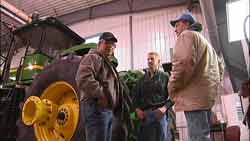Gettysburg, South Dakota. This is a story about a farmer, Dan Forgey, and his connection to the land, and the community in which he has lived throughout his life. This is also a story about a true pioneer, and the pioneering spirit that seems to inspire this particular community of farmers to farm in a different manner.
Potter County is an enclave of no-till farmers. As the name implies, no-till is an alternative method of farming that leaves the land undisturbed (not tilled) for planting crops. Among the purported benefits of no-till, it improves (rather than diminishes) soil health, increases productivity, reduces input costs (lesser need for fertilizers) and sequesters (holds) atmospheric carbon in the soil that otherwise would contribute to climate change.
Forgey’s home town of Gettysburg, South Dakota, was established in the 1880’s. With the arrival of the railroad, and the federal government’s offer to Civil War veterans of free open land for homesteading, new settlers arrived in droves to this area. By the turn of the century, Potter County comprised 860 square miles of area; most of this arable land became dedicated to agriculture production on 160-acre plots.
As Forgey explains in more detail about his no-till methods (see related how-to video: The Next Step: Adding Cover Crop to a No Till System ), he has been growing crops on the Cronin Family Farm for more than 40 years. What he has always loved most about farming is the soil. It’s been his cherished belief that if you take care of the land, it will take care of you.
For Forgey, the land not only provides the means of making a living as a farmer; it grounds his connection to the open prairie, the howling winds, and to Potter County, his home.
Most of the videos featured on Cooking Up a Story were produced, filmed, and edited by Rebecca Gerendasy. Fred Gerendasy contributed as a writer to many of the posts and occasionally as the interviewer. Visit Rebecca Gerendasy Clay – Art and Fred Gerendasy Photography to see their current work.

